Reviews
Anthony Mann
USA, 1950
Credits
Review by Lindsay Peters
Posted on 30 January 2013
Source
Categories Noir Mann
On the surface, Side Street appears to be little more than a high class installment in Mann’s grand narrative of good guys done wrong — though, in this case, the good guy is a little more culpable (and therefore more intriguingly layered) than usual. In his memoirs, leading man Farley Granger aptly describes the film as “a good looking, well-made film that was not able to rise above the banality of its story.” Admittedly, it’s hard to dispute the film’s glaring plot similarities to Mann’s earlier work. Side Street is in many ways a glossier version of RKO’s Desperate (1947) — a married man is blamed for a crime he didn’t commit and takes on the real crooks in order to protect a wife and newborn baby. Side Street was Mann’s second effort for MGM, which at the time was the biggest game in town for Hollywood players, and marked the beginning of Mann’s ascent to the big budget Westerns that would cement his career in the twilight years of the studio system. While Side Street may play it safe in terms of noir narrative, it makes for a solid contribution to that other beloved genre, the New York film.
The film opens with a series of Manhattan aerial shots, clearly the result of the then-stellar MGM bankroll. Cut to a New York slice-of-life montage, narrated in voiceover by the NYPD homicide chief who describes the city as “an architectural jungle where fabulous wealth and the deepest squalor live side by side.” This dash of cultural realism echoes the documentary elements previously seen in the L.A.-centric He Walked By Night, which also seems to have influenced Side Street’s multifaceted narrative structure. While initially set up as a story told from the chief’s point of view, Side Street quickly evolves into an intricate series of plot lines and a revolving set of characters representing the ever expanding and often intersecting problems that walk the city streets. This particular set of New York problems begins with a well to do businessman withdrawing $30 000 from the bank, the payoff for a honey trap blackmail scheme orchestrated by Backett, a crooked lawyer, his ex-con client George Garsell and doomed front girl Lucky Colner. Farley Granger is our hero, Joe Norson, a part-time mailman who dreams of a mink coat and a better life for his pregnant wife. The lure of $200 dropped on the floor of Backett’s office during his daily delivery proves to be too much for Joe, prompting him to seize opportunity when he later discovers the office to be unlocked and empty. Joe breaks open the filing cabinet and steals what he thinks is the $200, only to find that he’s instead come away with the $30 000 payoff. This ill-conceived theft sets off a chain of events that soon finds Joe on the run as a murder suspect, blindly conducting his own investigation and dodging Garsell, who will stop at nothing to retrieve his money and settle the score.
Side Street is unfortunately saddled with a few noticeable narrative and formal inconsistencies — the chief’s voiceover returns during the theft scene to describe and justify what’s going through Joe’s mind, a clumsily wrought device that smacks of post-production afterthought. In the hands of any other director, Side Street would have been instantly forgotten with its formulaic plot and half-baked narrative devices, but once again Mann offsets an unpromising script with a first rate cinematographer. Gaslight’s Joseph Ruttenberg expands on Mann’s signature visual flair with a series of beautifully lit close-ups and inventive framing that incorporates set design into shot set-up. Side Street also benefits from a crackerjack cast that includes Granger’s They Live By Night co-star Cathy O’Donnell, who brings a dose of fresh-faced realism to her role as Joe’s unwaveringly loyal wife. The inestimable Jean Hagen appears far too late in the action as a smalltime nightclub singer-cum-gun moll brought down by her fondness for the bottle and Garsell. As the narrative linchpin who brings Joe and Garsell together for the final showdown, Hagen’s performance is the third act shot in the arm Side Street needs, but she is sacrificed too soon, another victim in Garsell’s never-ending trail of bodies.
Side Street culminates in a textbook car chase scene that makes full use of the narrow streets and alleyways of the Financial District, the old Third Avenue El train lumbering in the background. Joe, held at gunpoint in Garsell’s runaway taxicab, personifies the anxiety-filled claustrophobia brought on by the oppressive urban architecture. After a shootout in front of the Federal Hall, Garsell is finally defeated and Joe is wheeled away in a stretcher with the promise of a full recovery and the sympathetic ear of the law. The city’s moral balance is restored by another job well done by the NYPD, and the class divide remains reassuringly constant — the rich stay safely rich in the towers of Central Park West, and the poor stay poor as the price for their honesty.
More Noir Mann
-
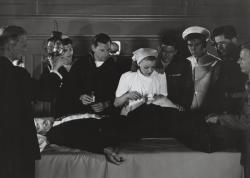
Strangers in the Night
1944 -
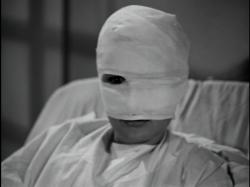
Strange Impersonation
1946 -
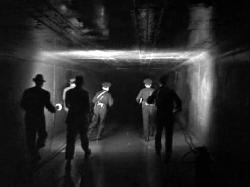
He Walked By Night
1948 -
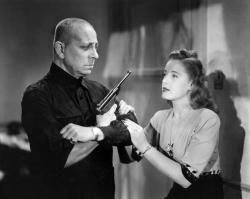
The Great Flamarion
1945 -
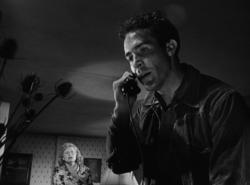
Border Incident
1949 -
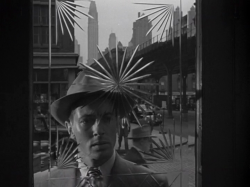
Side Street
1950 -
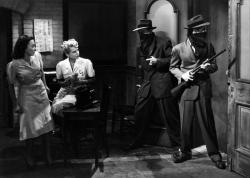
Railroaded
1947
We don’t do comments anymore, but you may contact us here or find us on Twitter or Facebook.



